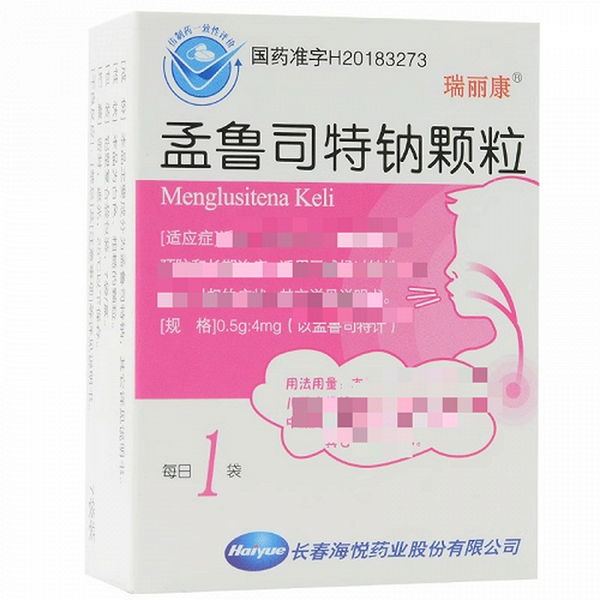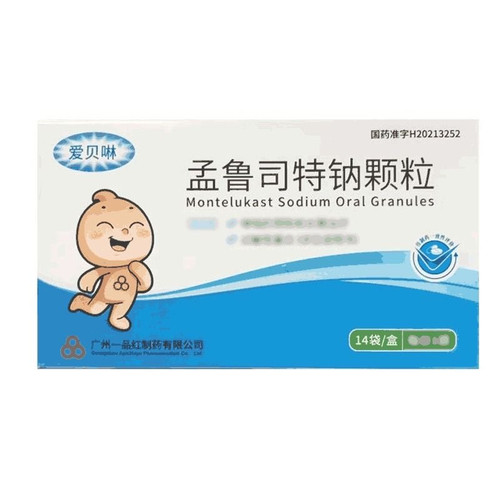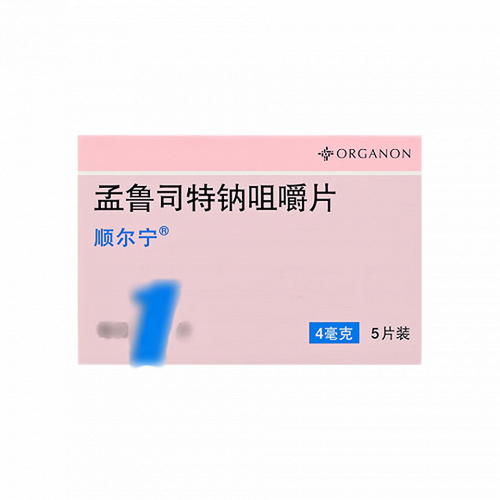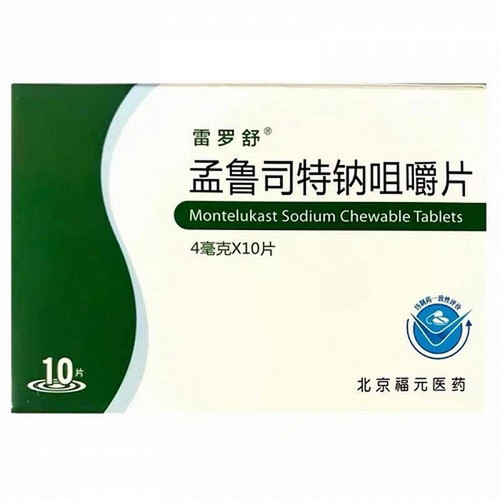Product Overview
[Drug Name]
Generic Name: Montelukast Sodium Oral Granules
Trade Name: Ruilikang
English Name: Nontalukast Sodium Oral Granules
Chinese Pinyin: Menglusitena Keli
[Ingredients]
The main ingredient of this product is montelukast, whose chemical name is [R-(E)]-1-[[[1-[3-[2-(7-chloro-2-quinolinyl)vinyl]phenyl]-3-[2-(1-hydroxy-1-methylethyl)phenyl]propyl]thio]methyl]cyclopropaneacetic acid sodium.
[Properties]
This product is white, rough granules.
[Indications]
This product is indicated for the prevention and long-term treatment of asthma in children aged 1 year and older, including prevention of daytime and nighttime asthma symptoms, treatment of aspirin-sensitive asthma, and prevention of exercise-induced bronchoconstriction. This product is also indicated for the relief of symptoms caused by hyperrhinitis (seasonal hyperrhinitis and perennial hyperrhinitis in children aged 2 to 5 years).
[Dosage and Administration]
Once daily. Asthma patients should take the medication at bedtime. Allergic rhinitis patients can take the medication at a later time depending on their condition. Patients with both asthma and allergic rhinitis should take the medication once nightly. Children aged 1 to 2 years with asthma should take one sachet once daily. Children aged 2 to 5 years with asthma and/or allergic rhinitis should take one sachet of 4mg oral granules daily. Oral granules can be taken directly, mixed with one spoonful of room temperature or cold food (such as applesauce), or dissolved in one teaspoon of room temperature or cold infant formula or breast milk. The package should not be opened until the time of use. After opening the package, the entire dose should be taken immediately (within 15 minutes). This product should not be dissolved in liquids other than infant formula or breast milk. However, water is acceptable after taking the product. It is generally recommended to evaluate treatment efficacy based on asthma control indicators. The efficacy of this product is apparent within one day of medication. This product can be taken with or without food. Patients should be advised to continue taking this product regardless of whether their asthma is under control or exacerbations. No dosage adjustment is required for patients with renal insufficiency, mild to moderate hepatic impairment, or regardless of gender. Regarding the relationship between this product and other asthma treatment medications, this product can be added to a patient's existing treatment regimen. Reducing the dose of concomitant medications: For patients whose asthma is not effectively controlled with bronchodilators alone, this product can be added to their treatment regimen. Once a clinical response is observed (usually after the first dose), the bronchodilator dose can be reduced based on the patient's tolerance. For patients receiving inhaled corticosteroids for asthma, the dose of the corticosteroid can be appropriately reduced based on the patient's tolerance. This should be done gradually under the guidance of a physician. Some patients can gradually reduce the dose until inhaled corticosteroids are completely discontinued. However, this product should not be used abruptly to replace inhaled corticosteroids or on a physician's advice.
[Adverse Reactions]
This product is generally well tolerated, with mild adverse reactions that generally do not require discontinuation of treatment. The overall incidence of adverse reactions with the reference product is similar to that with placebo. The safety of the reference product has been evaluated in 573 children aged 2 to 5 years with asthma. In a 12-week, placebo-controlled clinical study, the only drug-related adverse event with a 1% incidence in the reference product group and a higher incidence than in the placebo group was thirst. There was no significant difference in the incidence of thirst between the two groups. A total of 426 children aged 2 to 5 years have been treated with the reference product for at least 3 months, 230 for 6 months or longer, and 63 for 12 months or longer. The incidence of adverse events did not change with longer duration of treatment with the reference product. The safety of the reference product has been evaluated in approximately 175 children aged 6 months to 2 years with asthma. In a 6-week placebo-controlled clinical study, adverse events that were drug-related, with an incidence of 1% in the original product treatment group and a higher incidence than in the placebo group were diarrhea, hyperkinesia, asthma, eczematoid dermatitis, and rash. However, there was no significant difference in the incidence of these adverse reactions between the two groups. In a 2-week placebo-controlled clinical study, the safety of the original product has been evaluated in 280 pediatric patients aged 2 to 14 years with seasonal allergic rhinitis. The original product was well tolerated when taken once daily in the evening, and the incidence of adverse reactions was similar to that of the placebo group. In this study, the incidence of adverse reactions in the original product treatment group was less than 1%, and no adverse reactions that were drug-related and had a higher incidence than the placebo group were found. A pooled analysis of clinical practice was conducted using validated suicidal behavior assessment methods to pool 41 placebo-controlled clinical studies (35 studies in patients 15 years of age and older and 6 studies in children 6 to 14 years of age). Among 9,929 patients taking the original product and 7,780 patients taking placebo, one patient with suicidal ideation took the original product. No completed suicidal ideation, suicidal attempt, or preparatory action for suicidal behavior occurred in either group. A separate pooled analysis was conducted to assess behavioral-related adverse events in 46 placebo-controlled clinical studies (35 studies in patients 15 years of age and older and 11 studies in pediatric patients 3 months to 14 years of age). The incidence of behavioral-related adverse events was 2.73% and 2.27%, respectively, in 11,673 patients taking the original product and 8,827 patients taking placebo; the odds ratio was 1.12. (95% CI [0.93:1.36]). The clinical trials included in these pooled analyses were not specifically designed to examine suicide rates or behavioral-related adverse events. Post-marketing experience The following adverse reactions have been reported after the original product was marketed: Infectious and infectious: upper respiratory tract infection. Blood and lymphatic system disorders: increased bleeding tendency, thrombocytopenia. Immune system disorders; including hypersensitivity reactions such as allergic reactions, and very rare eosinophilic infiltration of the liver. Psychiatric disorders: including aggressive behavior or hostile sexual excitement, anxiety, depression, loss of orientation, inattention, abnormal dreams, hallucinations, insomnia, memory impairment, psychomotor hyperactivity (including irritability, restlessness and tremors), sleepwalking, suicidal thoughts and behaviors (suicide), convulsions. Nervous system disorders: dizziness, drowsiness, paresthesia/ Decreased tactile sensation and, very rarely, seizures. Cardiac disorders: Palpitations. Respiratory, thoracic, and mediastinal disorders: Epistaxis; pulmonary eosinophilia. Gastrointestinal disorders: Diarrhea, malabsorption, nausea, pancreatitis, vomiting. Hepatobiliary disorders: Elevated ALT and AST; very rarely, hepatitis (including cholestatic, hepatocellular, and mixed liver damage). Skin and subcutaneous tissue disorders: Angioedema, contusions, erythema multiforme, erythema nodosum, pruritus, rash, Stevens-Johnson syndrome/toxic epidermal necrolysis, urticaria. Musculoskeletal and connective tissue disorders: Arthralgia, including myalgia with muscle cramps. Renal and urinary disorders: Enuresis in children (rarely). Other disorders and administration site conditions: Asthenia/fatigue, edema, fever.
[Contraindications]
This product is contraindicated in patients with hypersensitivity to any of the ingredients.
[Precautions]
The efficacy of this oral medication for the treatment of acute asthma attacks has not been established. Therefore, it should not be used to treat acute asthma attacks. Patients should be informed to have appropriate rescue medications available. Although the dose of concomitant inhaled corticosteroids can be gradually reduced under the guidance of a physician, this medication should not be used abruptly to replace inhaled or oral corticosteroids. Patients receiving anti-asthma medications, including leukotriene receptor antagonists, have rarely experienced one or more of the following: eosinophilia, vascular rash, worsening pulmonary symptoms, cardiac complications, and/or neuropathy (sometimes diagnosed as Cura-Strauss syndrome, a systemic eosinophilic vasculitis). These conditions are sometimes associated with reduction or discontinuation of oral corticosteroid therapy. Although a causal relationship between these conditions and leukotriene receptor antagonists has not been established, caution and appropriate clinical monitoring are recommended for patients receiving this medication. Patients with rare hereditary conditions such as galactose intolerance, lactase deficiency, or glucose-galactose malabsorption should not take this medication. Montelukast may have little or no effect on the ability to drive or operate machinery. However, there have been isolated reports of drowsiness and dizziness. Neuropsychiatric events have been reported in adults, adolescents, and children taking the brand name product. Postmarketing reports of these events have included agitation, aggressive behavior or hostility, anxiety, depression, disorientation, attention deficit disorder, abnormal dreams, hallucinations, insomnia, irritability, memory impairment, restlessness, sleepwalking, suicidal thoughts and behaviors (including suicide), convulsions, and tremors. Clinical details in some postmarketing reports of the brand name product appear consistent with drug-induced effects. Psychiatric events have been reported in patients taking the brand name product (see Adverse Reactions). Because other factors may contribute to these events, a relationship to the brand name product cannot be confirmed. Physicians should discuss these adverse events with patients and/or caregivers, who should be instructed to notify their physician if they occur. Patients with known aspirin sensitivity should continue to avoid aspirin or nonsteroidal anti-inflammatory drugs when using this product ophthalmically.
[Use in Special Populations]
Precautions for Use in Children:
The efficacy and safety of the reference product have been studied in children aged 6 months to 14 years (see Dosage and Administration); safety and efficacy in children under 6 months of age have not been studied. Studies have shown that the reference product does not affect growth rate in children.
Precautions for Pregnancy and Lactation:
Not applicable.
Precautions for Elderly:
Not applicable.
[Drug Interactions]
The reference product can be used in combination with other medications commonly used for the prevention and long-term treatment of asthma and the treatment of allergic rhinitis. In drug interaction studies, the reference product at the recommended dose did not produce clinically significant pharmacokinetic effects on the following drugs: theophylline, prednisone, prednisolone, oral contraceptives (ethinyl estradiol/norethindrone 35/1), terfenadine, digoxin, and warfarin. Thyroid hormones, sedative-hypnotics, NSAIDs, benzodiazepines, and decongestants: Although no additional specific interaction studies have been conducted, no clinically relevant adverse interactions have been demonstrated with the reference product in clinical studies with commonly used prescription medications, including thyroid hormones, sedative-hypnotics, NSAIDs, benzodiazepines, and decongestants. Montelukast's area under the plasma concentration-time curve (AUC) was reduced by approximately 40% in patients receiving concomitant phenobarbital. Because montelukast is metabolized by CYP3A4, 2C8, and 2C9, montelukast should be coadministered with CYP3A4, 2C8, and 2C9 inducers (e.g., phenytoin, phenobarbital, and rifampin), particularly in children. However, no dose adjustment is recommended. In vitro studies have shown that montelukast is a CYP2C8 inhibitor. However, data from a clinical drug-drug interaction study between montelukast and rosiglitazone (a typical probe substrate primarily metabolized by CYP2C8) demonstrated that montelukast does not inhibit CYP2C8 in vivo. Therefore, montelukast is not expected to affect drugs metabolized by this enzyme (e.g., paclitaxel, rosiglitazone, repaglinide). In vitro studies have shown that montelukast is a substrate of CYP2C8, 2C9, and 3A4. A clinical drug-drug interaction study involving montelukast and gemfibrozil (an inhibitor of CYP2C8 and 2C9) demonstrated that gemfibrozil increased the systemic exposure of montelukast by 4.4-fold. Coadministration of itraconazole, a strong CYP3A4 inhibitor, with gemfibrozil and montelukast did not further increase the systemic exposure of montelukast. In clinical safety studies using doses greater than the approved 10 mg dose in adults (e.g., 200 mg/day for 22 consecutive weeks and up to 900 mg/day for approximately one week), no clinically significant adverse events were observed. Based on these data, the effect of gemfibrozil on montelukast systemic exposure is not considered clinically relevant. Therefore, no dose adjustment of montelukast is required with coadministration of gemfibrozil. Based on in vitro data, clinically significant drug interactions are not expected between montelukast and other known CYP2C8 inhibitors (e.g., trimethoprim). Furthermore, coadministration of montelukast with itraconazole alone does not significantly increase the systemic exposure of montelukast.
[Pharmacology]
Pharmacology: Cysteinyl leukotrienes (LTC4, LTD4, LTE4) are inflammatory mediators released by a variety of cells, including mast cells and eosinophils. These important pro-asthma mediators bind to cysteinyl leukotrienes (CysLT) receptors. Type I cysteinyl leukotriene (CysLT1) receptors are distributed throughout the human airways (including airway smooth muscle cells and airway macrophages) and other proinflammatory cells (including eosinophils and certain bone marrow stem cells). CysLTs are implicated in the pathophysiology of asthma and allergic rhinitis. In asthma, leukotriene-mediated effects include a range of airway responses, such as bronchoconstriction, mucus secretion, increased vascular permeability, and eosinophil accumulation. In allergic rhinitis, CysLTs are released from the nasal mucosa during both the immediate and delayed phases following allergen exposure, contributing to the symptoms of allergic rhinitis. Intranasal CysLT stimulation increases nasal airway resistance and symptoms of nasal obstruction. This product is a potent oral formulation that significantly improves inflammatory markers in asthma. Biochemical and pharmacological assays demonstrate that montelukast has high affinity and selectivity for the CysLT1 receptor (compared to other pharmacologically important airway receptors such as prostanoid, cholinergic, and β-adrenergic receptors). Montelukast effectively inhibits the physiological effects of LTC4, LTD4, and LTE4 binding to the CysLT1 receptor without any receptor agonist activity. Current studies suggest that montelukast does not antagonize the CysLT2 receptor. Toxicology: Acute Toxicity: No mortality occurred in mice and rats following single oral administration of montelukast sodium at doses up to 5000 mg/kg (15000 mg/m2 and 29500 mg/m2 in mice and rats, respectively). This dose represents the maximum dose tested (oral LD50 > 5000 mg/kg) and is equivalent to 25,000 times the recommended daily dose for adults*. Long-term Toxicity: Studies in monkeys and rats lasted up to 53 weeks, and in infant monkeys and mice up to 14 weeks. Results from trials showed that montelukast sodium was well tolerated and had a wide safety margin. No effects on toxicological parameters were observed in any of the experimental animals at doses at least 125 times the recommended human dose.* No instances of montelukast sodium withholding at therapeutic doses were observed in either adult or pediatric patients. Carcinogenicity: Montelukast sodium was not found to be carcinogenic in studies conducted in rats at oral doses up to 200 mg/kg/day for 106 weeks and in mice at oral doses up to 100 mg/kg/day for 92 weeks. These doses are equivalent to 1000 and 500 times the recommended adult dose.* Mutagenicity: Montelukast sodium was not found to be genotoxic or mutagenic. Montelukast sodium was negative in in vitro microbial mutation assays and in V-79 mammalian cell mutation assays, both with and without metabolic activity. Genotoxicity was not observed in in vitro rat hepatocyte alkaline elution assays and Chinese hamster ovary cell chromosome aberration assays, both with and without microsomal enzyme activity systems. Similarly, no chromosomal abnormalities were observed in bone marrow cells following oral administration of montelukast sodium to male or female mice at doses up to 1200 mg/kg (3600 mg/m²) (6000 times the recommended adult daily dose*). Reproductive Toxicity: No effects on fertility or reproductive capacity were observed in oral studies of montelukast sodium in male rats at doses up to 800 mg/kg/day and in female rats at doses up to 100 mg/kg/day. These doses are 4000 times and 500 times higher than the recommended adult dose, respectively*. Developmental Toxicity: No treatment-related adverse effects were observed in developmental toxicity studies of montelukast sodium at doses up to 400 mg/kg/day in rats and 100 mg/kg/day in rabbits. Fetal exposure to montelukast sodium did occur in rats and rabbits, and montelukast sodium was significantly detected in the milk of lactating rats. Pharmacokinetics: Absorption: Montelukast is rapidly and completely absorbed after oral administration. Studies conducted in adults on a fasting diet demonstrated that the 4 mg oral granules were bioequivalent to the 4 mg chewable tablets. Concomitant administration of applesauce or a standard meal had no clinically significant effect on the pharmacokinetics of montelukast, as measured by AUC (AUCs were 1225.7 and 1223.1 ng·hr/mL with or without applesauce, respectively; and 1191.8 and 1148.5 ng·hr/mL with or without a standard meal, respectively). Distribution: Montelukast sodium is more than 99% bound to plasma proteins. The steady-state volume of distribution of montelukast averages 8 to 11 liters. Studies of isotopically labeled montelukast in rats showed that only minimal amounts of montelukast crossed the blood-brain barrier. Furthermore, minimal amounts of radiolabel were present in all other tissues 24 hours after administration. Metabolism: Montelukast is almost completely metabolized. In studies using therapeutic doses, no metabolites of montelukast were detected in plasma at steady-state in adults and children. In vitro studies using human liver microsomes have shown that cytochromes P450 3A4 and 2C9 are involved in the metabolism of montelukast. Further in vitro studies using human liver microsomes have shown that therapeutic plasma concentrations of montelukast do not inhibit cytochromes P450 3A4, 2C9, 1A2, 2A6, 2C19, or 2D6. Excretion: The mean plasma clearance of montelukast in healthy adults is 45 ml/min. Following oral administration of isotope-labeled montelukast, 86% of the radioactivity was detected in stool collected over the next five days, with 9% of the radioactivity detected in urine. Clinical data on montelukast use in patients with montelukast.
[Storage]
Store tightly closed, protected from light, below 25°C.
[Specifications]
0.5 g: 4 mg (as montelukast).
[Packaging]
7 bags/box in aluminum-plastic composite bags.
[Validity Period]
24 months
[Approval Number]
National Medicine Standard H20183273
[Manufacturer]
Changchun Haiyue Pharmaceutical Co., Ltd.







